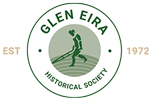I was born Margery Reed, at Ballarat in 1904. Before moving to Caulfield, I lived with my parents, one sister and one brother, at Jeetho, and Jumbunna, in South Gippsland.
In 1910 my family moved to Nathan Grove, Caulfield, near the corner of North and Hawthorn Roads. Caulfield in 1910 was so different from what it is today, paddocks as far as one could see, market gardens and dairy farms. There were not many houses between Kooyong and Hawthorn Roads.
During our early days in Caulfield, my family lived in a tent, and one room which father built. Father eventually built a five-roomed house, with the help of the Rev. Kelly, who was the Church of England minister at St. Catherine’s. Rev. Kelly helped build the house on Saturday afternoons, so dad would be able to attend church on Sundays.
St. Catherine’s, was then at the corner of Sycamore and Poplar Streets, it was moved to Kooyong Road about 1913 and we could easily walk to Church through the paddocks, and quite often see foxes, rabbits and snakes. There were a lot of snakes. We would often find a snake curled up in the outside toilet of our home, for warmth.
On bonfire nights, we would all have lots of fun, collecting branches from dead trees, and then have our own fire. Children from all around would come to our Bonfire, and we would have crackers, bung bungs, Catherine wheels, tom thumbs, but most of all, laughter.
As school children, to earn extra money for Christmas and Birthday presents, we would go to the local Market Gardens, and dig and bag potatoes for two shillings and sixpence a bag, or top and tail onions for the same payment.
Each year the pupils at our school, Caulfield State No. 773, would have penny concerts in the Caulfield Town Hall, and we all had to walk to the Town Hall, as the tram did not come that far.
Who can remember any of the teachers at Caulfield State No. 773 who were there during 1910-1914 Who can recall – The Head Master, Mr. Whitburn, Miss Whitburn, Miss Frost or Mr. Roberts?
When St Catherine’s Church was in Sycamore Street, we used to go into the Church and say our prayers each day before going to school. Miss Pretty and Miss Taylor were our Sunday School teachers, and Miss Taylor gave me a Bible in 1910 which I still have because I didn’t have one of my own.
The tramline was eventually extended from Elsternwick Station to Hawthorn Road, and all the local children collected used tram tickets with advertisements on them. When we collected a certain number, showing the same advertisement, we could get a free ticket to the Renown Theatre in Elsternwick.
We always used to walk from home in Nathan Grove to Elsternwick, to do our weekly shopping, but then our dad bought a horse and cart and I used to ride the pony to do the messages.
After World War I Mr. Alex Younger, who owned the mansion house “Fairfield Hall” Which was built in 1888, and is still a private home, sub-divided his land into building blocks and made Fairfield Grove, and Younger Avenue, so our children’s playgrounds were going.
At the Bambra Road side of the Brighton Cemetery, where the bush was very thick the gypsies and swagmen used to camp, they would stay for a while and then move on, but they came back each year at the same time. The Council Sanitary Depot was located here during 1910-1916
1919 The Flu Epidemic
I was a victim, and was taken to the Exhibition Buildings, which had been opened as an Emergency Hospital. I was there for four weeks, and saw many people die. It made a deep impression on me as I was only fifteen years old. Schools were closed and no one was allowed on the streets unless they wore a gauze mask over their mouth and nose. Some people even wore masks in their homes.
Along with hundreds of other patients, I lay on a mattress on the floor, and when someone died, the first to the vacant mattress claimed it as their own. I was one of the lucky ones. I recovered.
I eventually joined the O.S.T. Lodge, which used to hold their meetings in the Congregational Church Hall in Garden Vale Road. In 1921, we visited the Malvern O.S.T. Lodge, and I met the lad who was to become my husband for forty five happy years. He was an original ANZAC from the 1914-1918 war, and we were married at St Catherine’s Church in 1924, and came to live in Carnegie where we bought a house, in which I still live, for nine hundred and ninety nine pounds. We paid it off at one pound each week, over twenty years.
1926 The Great Depression
When the Depression started, many people lost their jobs. During 1927, the Federal Government brought in what was called Sustenance. Everyone out of work could apply for Sustenance, but they were required to work, mostly on making roads, laying tram tracks, and other community projects, for which they were paid one or two pounds each week. That helped to pay off this home we were buying.
When we came to live in Carnegie, in 1924, there were paddocks all the way to North Road, and just a few houses. My husband eventually was employed by the Caulfield City Council until his failing health caused him to retire in 1940.
I have lived in Caulfield since 1910 (seventy four years) and have many happy memories of this City. Memories of School, Church, O.S.T. Lodge, working for the Military Hospital, friends made, and lost.
Mrs. Margery Bromfield (nee Reed) kindly shared her recollections of life in Caulfield in The Caulfield Historical Newsletter in April 1984.
